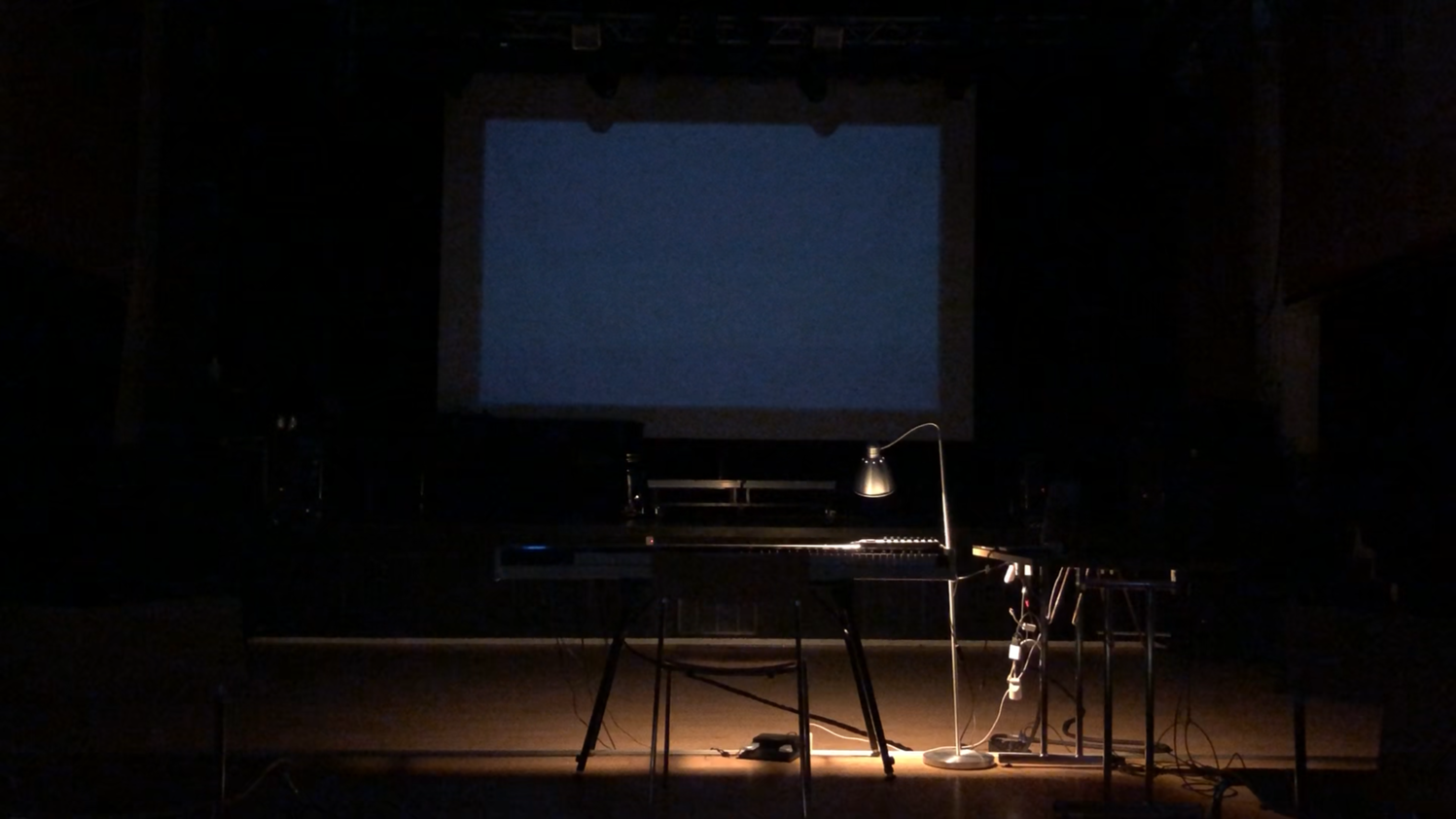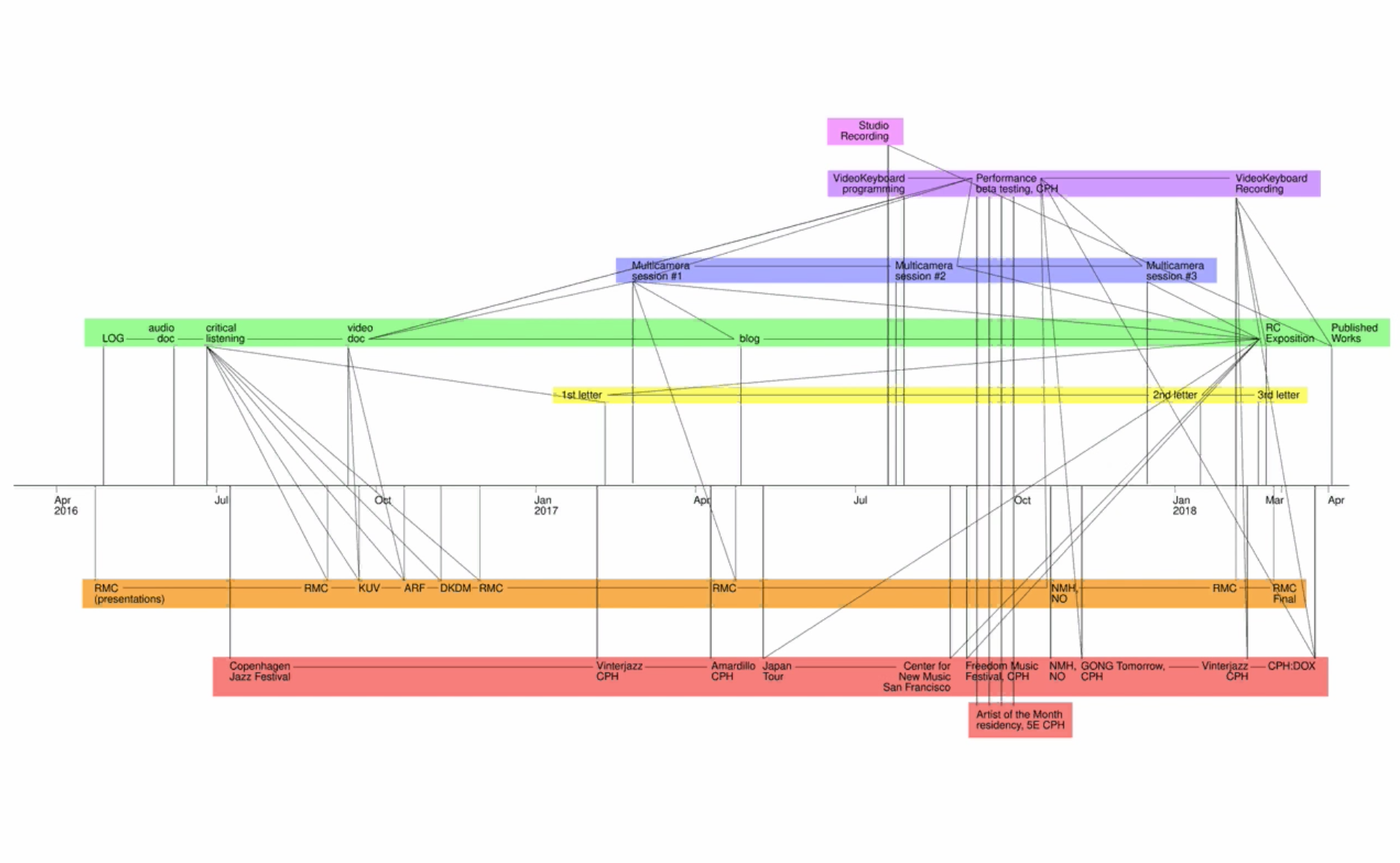Project info
- Project period 2016 - 2018
- Funded by RMC and the Danish Ministry of Culture's program for artistic research KUV (Kunstnerisk Udviklingsvirksomhed). The framework was 9 months full time distributed over 18 months.
- Public final presentation at RMC, February 28, 2018, including concert and audio-visual oral presentation. Peer response from two opponents (Jacob Anderskov and Christian Blom) as well as questions from the audience.
- Additional presentations at RMC, Den Danske Filmskole, Den Danske Scenekunstskole and Norwegian Academy of Music, Oslo (NMH).
- This exposition has been subject to critical comments by three peer reviewers (one internal, two international), based on RMC's artistic research quality criteria “SITRE”. Peer reviewers were Christian Blom, Ivar Grydeland and Jacob Anderskov (internal, RMC)
- The Video Keyboard has been used in other constellation and is the basis for the subsequent artistic research projects Interferences and Traversing Sonic Territories. Interferences was presented on the SAR2019 international conference on artistic research at ZHdK in Zürich in a presentation that was performed solely on the video keyboard.
- Concerts during the project period with material from the project held in, among other places, Copenhagen (Wundergrund Festival, CPH:DOX, Copenhagen Jazz Festival, Winter Jazz Festival, 5E, Politikens Hus, Koncertkirken, Freedom Miusic Festival), Tokyo (Airegin, SuperDeluxe, Candy Jazz), San Francisco (Center for New Music), Oslo (Norwegian Academy of Music, NMH), Aarhus (Radar) and Lemvig Gymnasium.
Credits
- Internal supervisor, associate professor, PhD, Head of Research, Lars Brinck
- External supervisor, professor emeritus, Bjørn Kruse (NO)
- External peer reviewers: Christian Blom and Ivar Grydeland
- Internal peer reviewer: Jacob Anderskov
- Video Keyboard programming and code - Gianluca Elia
- All multicamera sessions are filmed and directed by Andraes Johnsen at RMC and The Village, Copenhagen
- Multicamera session 1 and 3 are recorded at RMC and mixed by John Fomsgaard, multicamera session 2 is recorded by Thomas Vang at The Village
If we were to sum up this project and speak briefly of its possible contributions, the results could be arranged in the following categories: dissemination; instrument design and mapping; reflective listening methodology.
With the development of the video keyboard, I hope to contribute to the growing field of practice within multimedia dissemination. Pointing to a more exact location within this context is challenging, since the video keyboard is still developing, both as instrument/code and in relation to my disseminitative approach. [1]
However, it seems to fall somewhere in-between live video dissemination and the branch of presentation formats referred to as "performance-lectures" or "lecture-performances". Apart from the fact that I very rarely make use of voice or verbal content, performance-lectures are still contextually relevant, as they often include the presenter in a somewhat performative role of the dissemination.
Here it should be mentioned, that the performative aspect is played out from a position in-between audience and stage/screen. Both facing the screen, an as such, sharing the audience perspective, while performing what is on it. In this regard both performing the presentation and experiencing the performative presentation as a reciever.
This method of playing and improvising on research documentations (logbook notes, drawings, memo's, graphics, photography, audio and video recordings) in a performative context is still a fairly new field of practice. [2]
This also links back to the project's initial formulations about creating interplay between improvisatory and compositional approaches, through mobile, non-hierarchical form perspectives. A potential contribution to the field here, is the example of working with instrument-mapping as a compositional and structural foundation for a performance practice which is both disseminative, performative and improvisatory – and in that sense, leaving open the narrational timeline of the experience.
The project also hopes to contribute with methods on how to create a more immediate (and intermediate) interplay between observation and reflection in relation to listening-watching-reflecting on audio and video documentations. In this regard the method of "critical listening" proposes an approach in which one's reflections are verbalized and documented during the listening experience. This points in direction of non-textual reflective practices in which the artistic researcher can enter into a more sensorial relation with the documented research material.
This is possibly also relevant within teaching and education, concerning methods in artistic practice and research-based courses as a way to create synergies between material-oriented listening and critical reflection.
In the field of extended piano technique, the project hopes to contribute to the developing topographic approaches on the instrument – both in terms of the methodological concepts of stickworks, footworks and fieldworks, and by highlighting the kinaesthetic, proprioceptive faculties of the player/performer toward a more mobile, flexible positioning.
Also the use of "cluster sticks" (static and kinetic stickworks) seeks to connect to the technical invention by pianist and composer Henry Cowell and propose a continuation toward a more comprehensive and varied use of cluster sticks, which not only adheres to the conventional playing field of the keyboard but is also used on the entire instrument body.
Finally, the project hopes to be a ressource in terms of how solo artists and solo artist-researchers can work across a project's formats and conditions as a way of creating interaction and dynamic circuits within the project. Both in terms of laying out its various areas of practice (i.e. practical, performative, documentational, contextual) into a multilayered terrain/map for the artist-researcher to navigate. And in order to free up the mobility of the artist-researcher toward a more intuitive orientation across these grounds of practice.
This multi-stranded development process points back to multilayeredness as a concept that can potentially open up for diversity and multiplicity in the work of (solo) artists.

